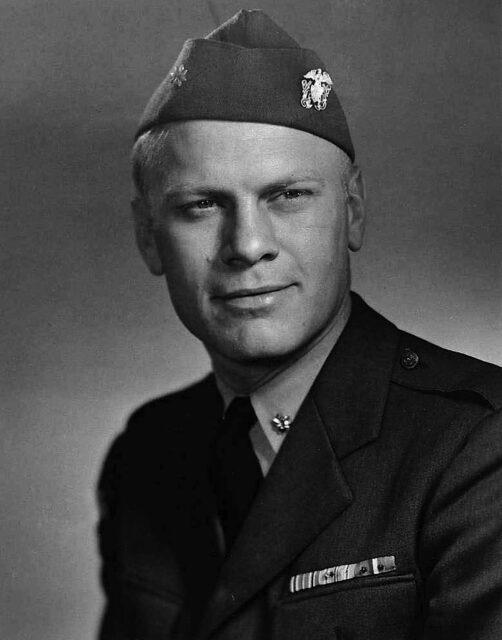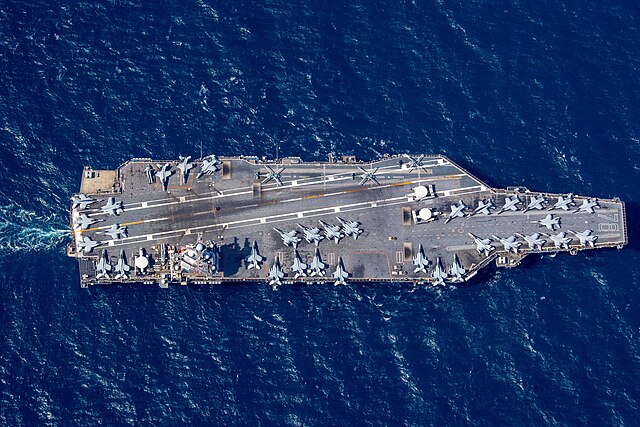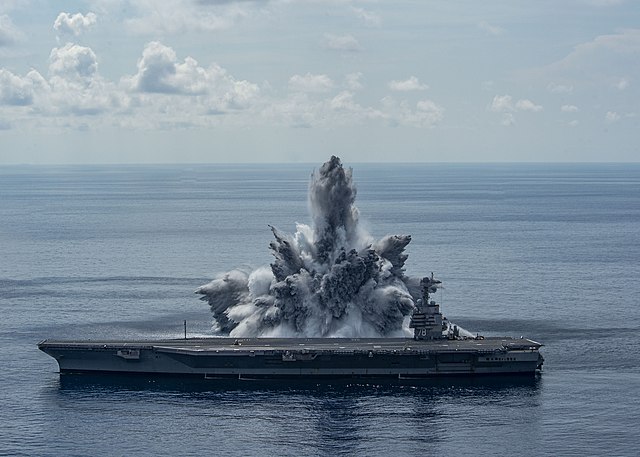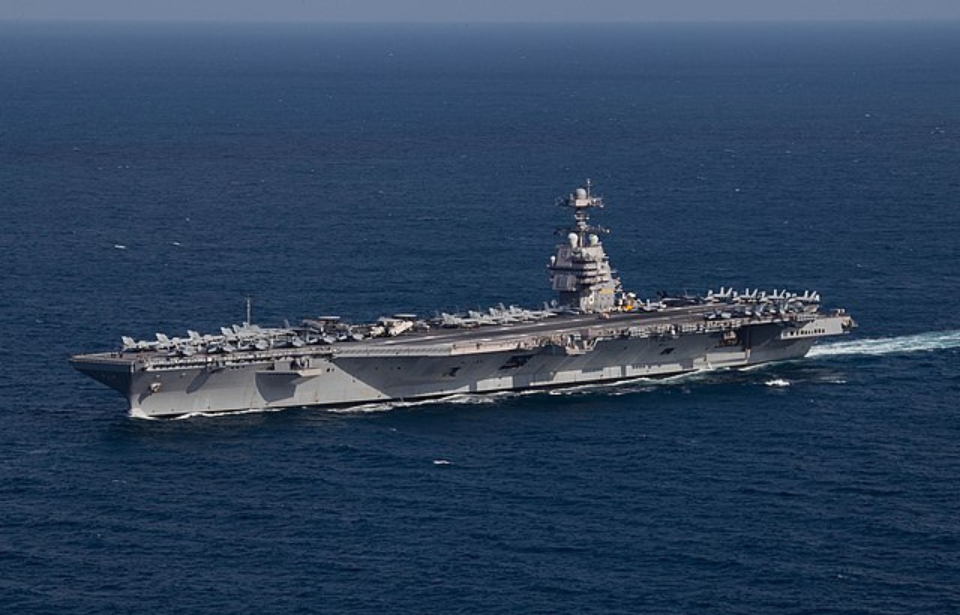The largest and most advanced aircraft carrier in existence, the USS Gerald R Ford (CVN-78) is what the newest generation of warships looks like. With an overall cost of more than $17 billion – $4.7 billion in R&D and another $12.8 billion spent during construction – the vessel is a mammoth on the high seas, and her extensive upgrades make the ship a formidable opponent.
Named for the 38th president of the United States, Gerald R Ford is the lead ship in her class of carriers, with four more planned over the course of the next decade. When compared to the earlier Nimitz-class vessels, it’s easy to see why the US Navy is moving in this direction.
Gerald Ford served in the US Navy throughout World War II

Gerald Ford joined the US Navy following the Japanese attack on Pearl Harbor in December 1941. Upon receiving a commission as an ensign in the Naval Reserve, he reported for active duty at the V-5 instructor school in Annapolis, Maryland, after which he served as an instructor at the Navy Pre-Flight School in Chapel Hill, North Carolina. Along with teaching a variety of key subjects, he also coached several sports, including swimming, football and boxing.
In June 1942, Ford was promoted to lieutenant, junior grade and the next year was, again, promoted, this time to lieutenant. A few months later, he was assigned to the USS Monterey (CVL-26), aboard which he served until 1944 as assistant navigator, anti-aircraft battery officer and athletic officer.
As a member of Monterey‘s crew, Ford participated in intense action in the Pacific Theater. This included securing Makin Island in the Gilbert Islands; carrier strikes on New Ireland, the Marianas, the Western Carolines, New Guinea, the Philippines, Wake Island and the Ryukyu Islands; the Battle of the Philippine Sea; and the landings on Kwajalein, Eniwetok, Mindoro and Leyte. He was also aboard the light aircraft carrier when she suffered damage during Typhoon Cobra.
Monterey was deemed unfit for service following the intense storm, after which Ford was assigned to the Navy Pre-Flight School at Saint Mary’s College of California, where he worked with the Athletic Department until April 1945. From then until January 1946, he was a staff member at the Naval Reserve Training Command at Naval Air Station Glenview, Illinois, before receiving an honorable discharge that February.
For his service during the Second World War, Ford received the World War II Victory Medal, the American Campaign Medal, the Asiatic-Pacific Campaign Medal with one Silver Star and four Bronze Stars, and the Philippine Liberation Medal with two Bronze Stars.
USS Gerald R Ford (CVN-78) specs

As aforementioned, the USS Gerald R Ford features a list of upgrades from the previous Nimitz-class, affording the carrier much better performance during operational service. The most notable change is her powerplant, which features two Bechtel A1B PWR nuclear reactors, HEU 93 percent and four shafts. Not only is this a more powerful system when compared to the A4W reactor, it also requires a far smaller crew to maintain, while producing speeds of up to 34.5 MPH.
While power is important when it comes to a naval vessel, it’s the technological advancements boasted by Gerald R Ford that are the real show-stoppers. The carrier features the Advanced Arrest Gear landing system, the integrated warfare Ship Self-Defense System (SSDS), both AN/SPY-4 S Band volume search and AN/SPY-3 X Band multi-function radar, and better stealth to reduce radar cross-section.
Gerald R Ford, as expected, is equipped with the latest weaponry, including two RIM-162 Evolved SeaSparrow Missile (ESSM) launchers, two RIM-116 Rolling Airframe Missiles (RAMs), three Phalanx Closed-In Weapons Systems (CIWS), four Mk 38 25 mm Machine Gun Systems (MGS) and four classic M2 Brownings.
When it comes to aerial support, the carrier can house over 75 aircraft, which are launched using the Electromagnetic Aircraft Launch System (EMALS), as opposed to traditional steam catapults. This allows for 25 percent more launches than the Nimitz-class with 25 percent fewer crewmen.
As for the aircraft carried by Gerald R Ford, they include the Boeing EA-18G Growler, the Boeing F/A-18E/F Super Hornet, the Lockheed Martin F-35C Lightning II, the Grumman C-2 Greyhound, the Northrop Grumman E-2 Hawkeye, the Sikorsky SH-60 Seahawk and unmanned combat aerial vehicles.
In terms of crew, Gerald R Ford can host a complement of 4,539, who are housed in quarters that are without a doubt an upgrade from previous warships. The sleeping areas are quieter, there’s better air conditioning, and there’s an increase in gymnasiums and other recreational areas.
USS Gerald R Ford (CVN-78) enters operational service

While an advanced carrier, the USS Gerald R Ford experienced a number of hiccups during the construction process, including problems with her nuclear propulsion system and munitions elevators. This, therefore, delayed when the vessel could begin her testing trials, which didn’t finish until 2021.
In October 2022, Gerald R Ford left Naval Station Norfolk, Virginia for her first official deployment, during which the ship, along with NATO countries and allies, conducted exercises in the Atlantic Ocean. Half a year later, in May 2023, she left on her first full-length deployment in the Second and Sixth Fleet’s Area of Responsibility (AOR). By the 24th, she’d arrived near Oslo, Norway for more NATO exercises, and eventually transited to Croatia for crew rest.
More from us: A Panicked Crewman Led to the Loss of 99 British Lives Aboard the HMS Thetis (N25)
In October 2023, the carrier was conducting exercises in the Ionian Sea with the Italian Navy when the Israel-Hamas War broke out. The day following the initial attack, Gerald R Ford was directed to the Eastern Mediterranean “to bolster regional deterrence efforts,” along with the USS Normandy (CG-60), Ramage (DDG-61), Roosevelt (DDG-80), Thomas Hudner (DDG-116) and Carney (DDG-64).
